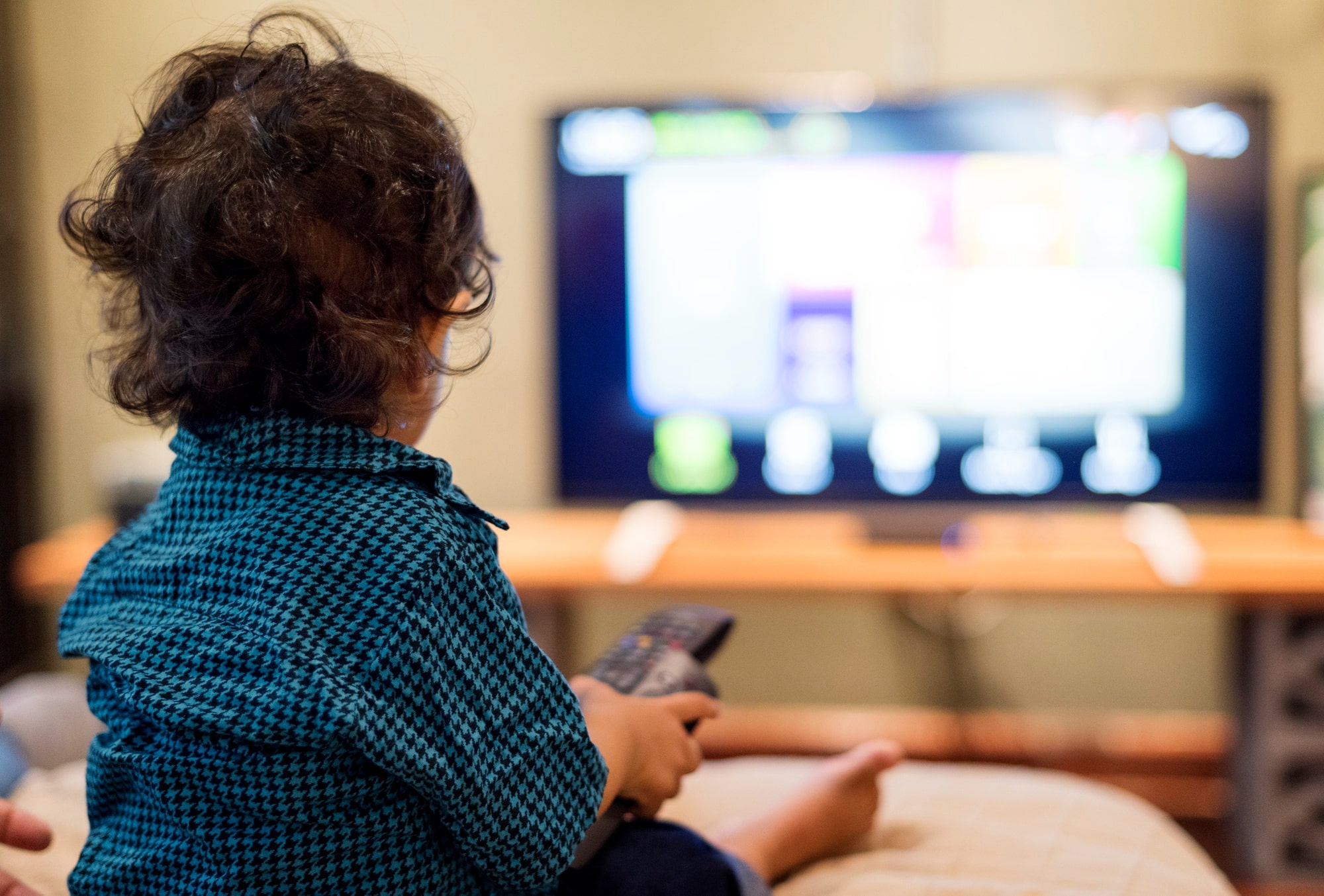Setting limits for kids watching TV is incredibly important in today’s digital age. We all know that kids love watching TV, but excessive screen time can have negative effects on their health and development. As parents, it’s our responsibility to establish guidelines for healthy screen use. In this article, we’ll discuss the importance of setting screen time limits, provide age-appropriate recommendations regarding digital media, and offer practical tips for managing your child’s TV viewing habits.
We can’t ignore the impact of the COVID-19 pandemic on screen time either. With schools moving to online learning and limited social interaction, children have been spending more time than ever in front of screens. While screens have provided educational and entertainment opportunities during these challenging times, it’s more important than ever to find a balance that protects their overall well-being.
Age-appropriate screen time limits – what does too much screen time mean?
The American Academy of Pediatrics (2020) has some valuable guidelines for parents regarding screen time limits for children of different age groups. By following these recommendations, you can ensure that your child maintains a healthy and balanced relationship with technology.
Toddlers (18 months to 2 years): The AAP suggests avoiding all screen time, except for video chatting with loved ones. We understand that technology has become an integral part of our lives, but at this age, it’s important for kids to explore the world through real-life experiences.
Preschoolers (2 to 5 years): Limit screen time to one hour per day of high-quality programming. Engage with your child while they watch and discuss the content together. This not only enhances their learning experience but also strengthens your bond.
School-age children (6 to 12 years): It’s important to set consistent limits on the amount of screen time for this age group. Make sure that your child has a healthy balance between screen time and other activities such as physical play, socializing, and completing homework.
Older children and adolescents (13 to 18 years): As your child grows older, make sure to encourage responsible and mindful screen use. Discuss the importance of time management and help them prioritize other activities such as hobbies, sports, and spending time with friends.
Are you wondering “Does watching TV count as screen time?” Absolutely! TV viewing involves prolonged exposure to screens, so it should be considered as part of your child’s overall screen time limits. Remember, it’s not just about TVs; smartphones, tablets, and other digital devices also contribute to their screen time – so we’re also talking about video games and social media.
👉 Ready to take control of screen time and avoid screens becoming “the babysitter”? Follow these 3 steps in our article: “Should Parents Limit Screen Time?“. Read it & reclaim quality family time!
How to Set limits Regarding Kids Watching TV
There are some practical strategies that will help you to set boundaries regarding your child’s media use.
1. Create a schedule for watching TV
Establish a schedule in order to reduce your kid’s screen time. Work with your child to create a schedule that works for your family, including specific time slots for TV viewing on weekdays and weekends. Setting specific boundaries regarding the hours of screen time will help your child to form a healthy routine.
2. Create a TV-Free Sanctuary: Keep the Bedroom Screen-Free
Keeping your child’s bedroom free from TVs is a great way to promote healthy sleep patterns and also to reduce the temptation to engage in excessive screen time. Encourage other activities, such as reading books or engaging in quiet play, before bedtime. This will help them unwind and prepare for a good night’s sleep.
3. Encourage educational and age-appropriate content
While making efforts to limit screen time, you also have to ensure that the content your child watches is not only entertaining but educational and age-appropriate. Look for TV shows that promote learning, creativity, and positive values. There are plenty of options available, such as educational programs or documentaries.

4. Encourage Co-viewing and active engagement
While it’s essential to set screen time limits, that doesn’t mean you should completely distance yourself from your child’s media consumption. Co-viewing and active engagement can turn TV time into a positive and interactive experience.
Here’s why it’s beneficial and some strategies to foster engagement:
- Bonding and Connection: watching TV with family mambers or other caregivers provides an opportunity for quality time.
- Guided Viewing: co-viewing allows you to guide your child’s understanding of the content they’re watching. Ask questions, discuss the storyline, and encourage critical thinking. For example, while watching a nature documentary, you can ask your young children about their favorite animal or discuss the challenges animals face in the wild.
- Extend the Learning: instead of viewing TV time as passive entertainment, consider ways to extend the learning experience. Encourage your child to draw or write about their favorite character or episode, reenact scenes through imaginative play, or create their own stories inspired by what they’ve watched.
- Engage in Discussions: use TV shows as a springboard for meaningful conversations. Discuss important themes, values, and real-life situations portrayed in the episodes. This not only enhances your child’s critical thinking skills but also helps them develop empathy, social skills and a deeper understanding of the world around them.
By actively engaging in your child’s TV viewing experience, you can transform it into a valuable opportunity for learning, bonding, and shared enjoyment.
5. Promote Healthy Viewing Habits
Optimal moments for TV viewing should be chosen thoughtfully, such as before or after mealtime, when the entire family can be present and enjoy it together.
During mealtime, create a screen-free zone that allows your child to fully focus on their food and engage in meaningful conversations with the family. This dedicated time fosters mindful eating habits and strengthens the bond among family members. It’s a valuable opportunity to connect, share experiences, and nurture healthy relationships.As bedtime approaches, encourage a screen-free hour to help your child unwind and prepare for a restful sleep. Screens emit blue light that can disrupt the production of melatonin (Hale, Kirschen, 2018), the hormone responsible for regulating sleep. Instead, establish a relaxing routine that promotes a peaceful transition to bedtime.
6. Balance Screen Time with Other Activities
While screen time can be a part of your child’s routine, it’s important to emphasize the significance of physical activity and outdoor play. Encourage your child to participate in age-appropriate sports, dance, or other physical activities. Schedule regular outdoor playtime, whether it’s at a park, in the backyard, or a family walk around the neighborhood. Make this kind of activities fun and engaging by involving the whole family.
7. Use parental control features
Technology and smart TV apps provide a lot of tools for parents to manage and monitor their child’s screen time. Use the parental control settings on devices and also install kid-friendly apps. These features allow you to restrict the time kids are spending in front of a screen and also block inappropriate content.
Some smart TVs and streaming services offer content filtering options that allow you to block inappropriate content. By setting up content filters, you can ensure that your child only accesses content that aligns with their age and developmental stage.
👉 Ready to level up your parenting game and tackle video game addiction in your child? Explore the causes and solutions in our article.
8. Be a role model
As a parent, your behavior and actions play a significant role in shaping your child’s relationship with screens. Being a positive role model is essential in teaching them healthy screen habits. Show your child the importance of balancing screen time with other activities.
Demonstrate responsible screen use making your own screen time rules, engaging in hobbies, spending quality time with family, and pursuing outdoor activities. When your child sees you practicing a healthy balance, they are more likely to follow suit.
9. Empower Your Child: Offer Him Choices for Screen Time Management
Empowering your child to make choices about their screen time can promote their decision-making skills and sense of responsibility. By offering options, you allow them to have a degree of control over their screen time.
Present your child with options for how they can spend their screen time. For instance, you can let them choose between watching one hour of their favorite TV show or going for a walk in the park and enjoying an ice cream afterward. This empowers them to make decisions while considering alternative activities.
Conclusion
In conclusion, setting screen time limits for children is necessary for healthy child development. Excessive TV watching can have detrimental effects on their health, social interactions, and cognitive growth. As parents, it is our responsibility to establish guidelines that promote a healthy relationship with technology while ensuring our children’s well-being.
Implementing the suggested guidelines and strategies discussed in this article will help create a balanced environment for your children. Regularly reassess and adjust the rules regarding watching TV based on your child’s needs and developmental stage. Let us embrace technology as a tool for learning and entertainment while providing our children with a well-rounded and enriching childhood experience.
So, go ahead and take the necessary measures to establish a positive and balanced TV routine for your children. They will thank you for it as they grow and thrive in a balanced digital world.
Are you concerned about the impact of screens on your child’s development? Are you ready to take proactive steps towards creating a healthier screen environment for your family? Join our parenting masterclass “Why Screens Harm Your Child: 5-Step Guide to Optimize Screen Time for Kids and Get Your Kid off Tablets, Phones & TV” and find out practical solutions for this problem.
Looking for more parenting advice? Connect with Sophie, our 24/7 AI assistant, who is here to provide valuable insights and solutions for your parenting journey.
References
Anderson, D., & Pempek, T. (2005). Television and Very Young Children. American Behavioral Scientist,48(5),505-522. http://doi.org/10.1177/0002764204271506
Hale, L., Kirschen, G. W., LeBourgeois, M. K., Gradisar, M., Garrison, M. M., Montgomery-Downs, H., Kirschen, H., McHale, S. M., Chang, A. M., & Buxton, O. M. (2018). Youth Screen Media Habits and Sleep: Sleep-Friendly Screen Behavior Recommendations for Clinicians, Educators, and Parents. Child and adolescent psychiatric clinics of North America, 27(2), 229–245. https://doi.org/10.1016/j.chc.2017.11.014
Stiglic, N., & Viner, R. M. (2018). Effects of screentime on the health and well-being of children and adolescents: a systematic review of reviews. BMJ Open, 9(1), 1-15. http://dx.doi.org/10.1136/bmjopen-2018-023191











